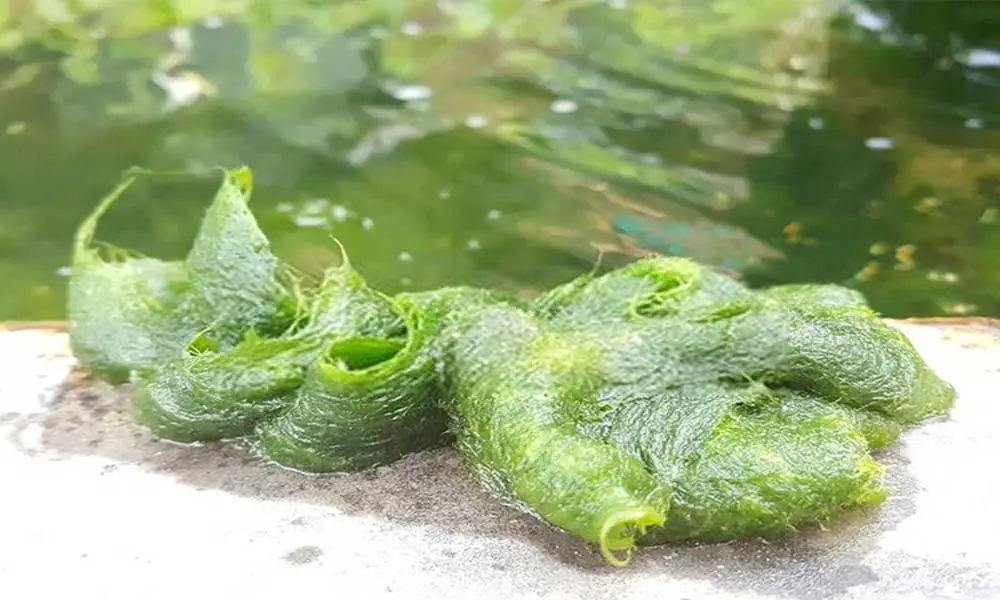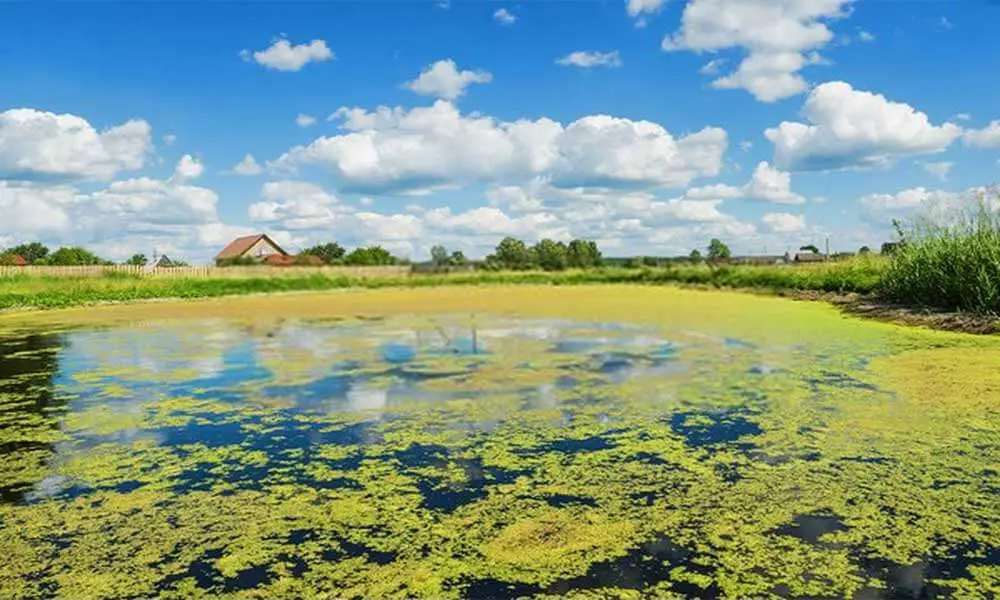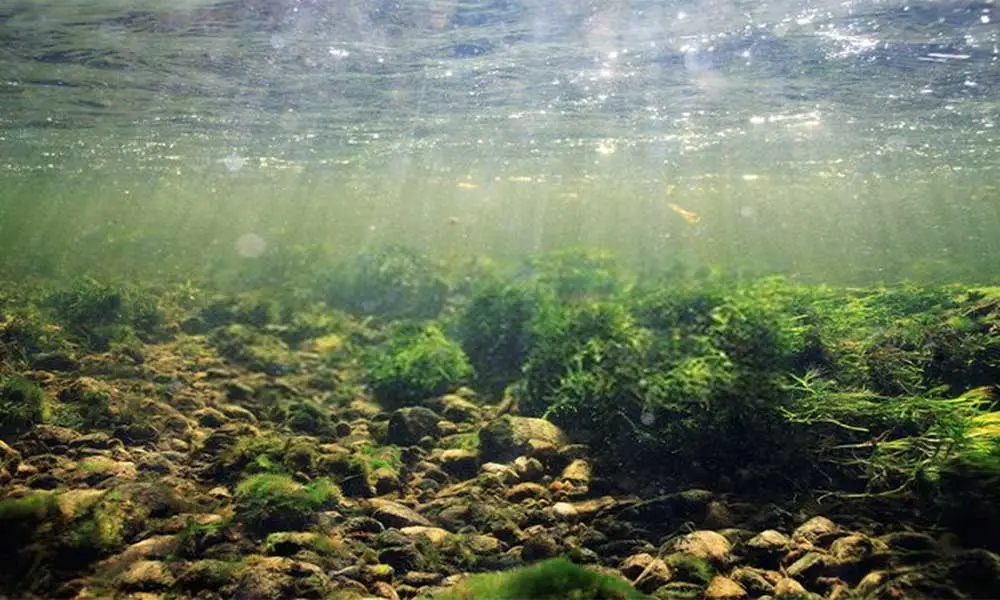Products recommended in this post contain affiliate links. If you buy something through our posts, we may receive a commission at no extra charge to you. See our full disclosures here.
How to remove algae from pond without harming fish? Ponds are a great addition to your home. The clear water of the pond offers a bit of freshness to your mood. Along with that, its mere presence improves the overall architecture of your house. In a nutshell, a pond in your house improves its value.
Now, some of us who have a pond at home must have observed a green layer over the water surface. This green layer is nothing but algae that harms the health of your pond. On the other hand, it develops by consuming resources of the pond. Keeping this in mind, it becomes extremely necessary to keep a regular check of pond water and eradicate algae if found.
In this article, we will dive into various types of algae along with some methods that one can undertake for removing them from the pond. Make sure that you follow the methods as they are explained in this article or you may end up harming the fish.

Types of Algae
Before proceeding to the causes and solutions of removing algae from the pond, let us take a look at the types of algae. The most common types of algae that are formed in the pond ecosystem are:
How to clean a pond without draining it- the step by step guide
There are many aquarium sump setup ideas and some of the hobbyists are also professionals in building their own sumps. If you are planning to add a sump to your aquarium setup, consider buying one instead of making it yourself.
Most of the commercial sumps come with the ability to customize them according to the user. This enables the user to make the required changes in order to get the best out of the sump.
Now you need to follow some simple steps in order to set up your sump. Let’s start.
1. Green Mat Algae
This type of algae is found most frequently in large ponds. The Green Mat algae are also known as the Filamentous Algae. The development of filamentous algae starts from the edges of the pond gradually rises to the surface forming a green layer over the water surface. Green Mat algae grow in the air where there is a high amount of calcium and phosphorus. They have a slimy and course texture which blocks the sunlight from reaching the inside of the pond. Thus, causing harm to the pond vegetation. Pond scum or moss are some common names of this algae.
2. Attached Erect Algae
This is another type of algae that can exist in your pond. This algae look like a vascular plant but is actually not. It has a dense structure and can cover the whole surface of the pond if not taken care of within time. One of the algae under this category is the blue-green algae. This species is the biggest culprit for algae bloom in the pond. When it comes to its growth, they only require nitrogen and carbon dioxide for surviving. The subcategories of blue-green algae that exist are of various different colors like red, brown or yellow. These algae are classified under the Monera kingdom and are also called as Nitrogen fixation organisms. Make sure you get rid of them as soon as possible or your fish may suffer.
These basic types of algae have to be taken care of while managing a pond at your home.
Did You Know?
Algae form the base of the food chain. Hence, they are also crucial for the pond.

What causes the growth of Algae in the pond?
In this section, we will discuss the various factors responsible for the formation of algae in the pond. Although, the categories of algae are less but many factors lead to the formation of algae in the pond. Let’s study these factors!!!
Pollution
This is the main factor for the formation of algae in the pond. The mixing of various nutrients from organic waste, both external and internal leads to the formation of algae in the pond. Although algae are important for the pond ecosystem but if the amount of algae is more than the required, it can cause serious harm to the pond water. The most common pollution that leads to the formation of Algae is land pollution. Fertilizers and other organic products add excessive nutrients to the pond water which also leads to the formation of algae.Light
Turbidity
The degree to which the water loses its transparent look is called turbidity. The presence of suspended particles in the water leads to a decrease in transparency in the water. Due to this factor, the development of the algae is triggered at that too at a faster rate. Suspended particles block the way of light into the water, which makes it heat faster in the presence of constant sunlight. This leads to the formation of algae on the water surface.Filtration System
The absence of an efficient filtration system also leads to the formation of algae in the pond. The water in the pond stays static all the time, which leads to the formation of algae in it. On installation of a biofiltration system, the water will be cleaned as well as the water will have regular movement. This will prevent the water from overheating at the surface. Also, the water will have less suspended particles. This, in turn, will prevent the formation of algae.
Sunlight is both advantageous and disadvantageous for the pond ecosystem. On one hand, it supports the survival of various water elements like fish, plants, etc. On the other hand, the presence of sunlight heats up the water, which leads to the growth of algae in it. Irrespective of the other life forms, algae thrive in the presence of sunlight. Plus, algae can also move from one spot to another in the water-based on the presence of sustainable conditions.

How to Remove Algae from the pond without harming Fish?
After discussing the factors responsible for algae formation and the types of algae in the pond, it is finally time to take on the methods for eradicating algae. This is kept in coordination with taking care of the fish. Let’s check the methods for algae removal.
1. Plants
The first in the line of how to remove algae from the pond without harming fish is planting of some aquatic plants. The presence of excess nutrients in the water leads to the formation of algae which harms and disbalances the whole pond’s ecosystem.
Hence, for preventing the formation of algae in the pond, plant some extra plants in it like:
- Lilypads
- Cattails
- Watercress
These plants will help in the absorption of the excess nutrients in the water. Hence, decreasing the possibility of algae formation. The presence of plants in the pond also keeps the water clear and enhances the look of your pond.
Did You Know?
To keep the algae from forming in the pond, cover at least 60% of the pond surface with plants.
2. Barley Straw
This is another way to curb the formation of algae in the pond. Adding barley straw to the pond forms the second method for how to remove string algae from pond without harming fish. The Barley straw needs to be added to the water in a controlled quantity as it releases hydrogen peroxide, which kills the algae but can also lead to the killing of plants. The production of hydrogen peroxide from barley straw is the result of its rotting. The amount of barley straw required for 1000 gallons of water is 8 ounces which are roughly 0.23 kilograms.
Check the Summit 130 Clear-water Barley Straw Bales on Amazon.
3. Overfeeding
Fish diet is also an important factor in the process of how to remove algae from pond without harming fish. What happens if the fish inside the pond are overfed? The overfeeding of fish leads to the wastage of fish food which rots with time inside the pond. The presence of rotten fish food triggers the formation of algae.
While feeding the fish, make sure that the fish consumes the food within five minutes. If the food is fed for more than five minutes, it will go to waste and rot. For buying fish food, Check out the TetraFin Balanced Diet.
4. Physical Method
This method deals with the physical removal of algae from the pond. It is one of the great pond algae solutions in which we use equipment like skimmer os algae net. The method of algae removal by such equipment is no doubt a faster one, but it is not feasible all the time. This method also forms the foundation of how to remove algae from pond without harming fish.
Take a look at U.S. Pool Supply Professional Heavy Duty skimmer rake for effective cleaning of pond algae.
5. Mechanical and Chemical Method
This step forms the last pillar for how to clean pond water with fish in it. The first step is to install a bubble aerator and water filter in the pond, which will maintain the constant movement of the water inside the pond.
Consider the Carefree Fish Air Stone Disk Kit for water aeration and ZENY Pressure Bio Filter for Pond.
Along with the biofilter, use an ultraviolet light sterilizer for destroying the algae.
Algaecides can also be used to destroy the algae but should be your last choice as they may harm the fish in the pond.
Did You Know?
Herbicides should be the last step for algae removal. They should be added after testing the alkalinity of the pond water.
Video Introduction
Conclusion
As you are well versed with all the necessary details about the algae removal process now. It will be pretty easy for you to take care of your pond at home by yourself. How to remove algae from pond without harming fish is not a tough process but needs proper care while performing it. Hence, you need to be extremely careful while undertaking the mentioned steps. I hope this guide helps you in the best way possible. Good Luck!!!
Top Editor's Choice on Removal Of Algae
[amazon bestseller="Removal Of Algae" filterby="price" filter="30" filter_compare="more" filter="available" orderby="percentage_saved" order="desc" template="list" items="10" tracking_id="tnk0c-aawp-cro-b-20"]Subscribe to our Newsletter!
Join our mailing list to receive the latest tips and news of our blog.



 Check Offer Prices [Amazon]
Check Offer Prices [Amazon]


